CRM Assignment: Implementation Of GSC to Control Demand & Supply To Enhance Customer Relationship Management
Question
Task:
Write a dissertation report on CRM assignment on the topic “The implementation of the GSC to control demand and supply to enhance customer”.
Answer
Acknowledgement
I would like to express my gratitude to my professors under whose guidance and direction, this CRM assignment has been successfully completed. I would also like to thank my librarian as that was my primary source of collecting data and information for conducting the research on this interesting topic. Besides, my peers also helped me by solving some of my issues related to the topic, and so I would like to show my gratitude to them also.
Abstract
GSCM is an emerging approach of the modern day businesses to meet the increasing concerns of the customers regarding the environmental issues. The aim of this research is to investigate on the implementation of GSCM to control demand and supply for enhancing the customer relationship management. The literature review in this area has identified a lack of information that describes the interrelationships between the three variables that are green supply chain, demand and supply and customer relationship management. To continue research is this area a secondary research method was chosen and for analysing the data collected from 15 peers reviewed journal articles, thematic analysis technique has been resorted to. The findings of the research indicate that GSC performs the role of a moderator on the relationship between the demand and supply and the customer relationship management (CRM). The moderator role of GSC positively acts of demand and supply management to enhance the ability of the organizations to manage the relationships with the customers.
Chapter – 1 – Introduction
1.0 Introduction
Green Supply Chain management (GSCM) is the approach to account for the environmental needs across the supply chain management encompassing different elements such as the design of the product, supplied materials, processing of the materials, transportation, reusing and recycling of the products. The present chapter introduces the aim and objectives of this research and sets the background of the research.
1.1 Background of the research
Through the past decades, the existence of the national and international restrictions and legislations, environmental pollution, global climate change and the enhancing environmental consciousness have resulted in growing attention of the organizations toward the development of sustainable supply chains and environmental management (Khan et al., 2018). However, there is a possibility for the existence of a few organizations that are unaware of the fact that by greening the supply chain management a mediating role can be performed between the demand management and the customer relationship management. Therefore, this research is based on the implementation of the green supply chain (GSC) to influence CRM through increased demand management.
1.2 Research aim and objectives
The aim of this research is to investigate the ways in which the implementation of the GSCM can control demand and supply and thereby, enhance the performance of CRM in organizations.
Objectives:
- To explore the concepts and importance of GSC, demand and supply as well as CRM
- To investigate the extent to which GSCM is able to control the demand and supply of the products and services
- To analyse the ways in which CRM is mediated by demand and supply under the influence of the GSC
1.3 Research Questions
- What are the concepts and importance of the green supply chain, demand and supply and customer relationship management?
- What is the extent to which GSCM is able to control the demand and supply of the products and services?
- How CRM is mediated by demand and supply under the influence of the GSC?
1.4 Rationale
According to Chelly, Hadj-Alouane, Noiura & Frein (2017), SCM is the process that assists the business organisations to store, convert and deliver the products and services in an efficient and effective manner. The GSCM was developed to involve the purchasing functions with the activities of reducing the waste material, recycling, replacement and reuse of materials. The GSC is a major organisational strategy that helps organisations in meeting the demands of the customers and fit the legal structures of the government. In the view of Choi, Min, Joo & Choi (2017), customers in recent times have a growing demand for the sustainable practices to be followed by the organisations in the management of supply chains. GSCM effectively improves the delivery of products by ensuring on-time delivery, enhancement of the product quality and better management of the products in the inventory levels. All these approaches impact positively on meeting customer demands and gaining greater CRM ability. However, organisations that do not implement GSCM are facing problems in managing the demand of the customers (Shibin et al., 2016). Therefore, the CRM which is the development of strong customer relationships based on marketing sales and service cycle is also negatively influenced by the weak demand management. Hence, the present research sheds the light on the implementation of GSCM for moderating CRM via enhanced demand management.
1.5 Significance of the research
As there is a possibility of the existence of organizations that have not implemented a green supply chain, the outcome of this research can help these organizations to understand its importance in gaining higher levels of demand management and customer relationship management. The research findings would be beneficial to other scholars or researchers conducting research in a similar subject area in the future by serving as a strong secondary source of data.
1.6 Structure of the Dissertation
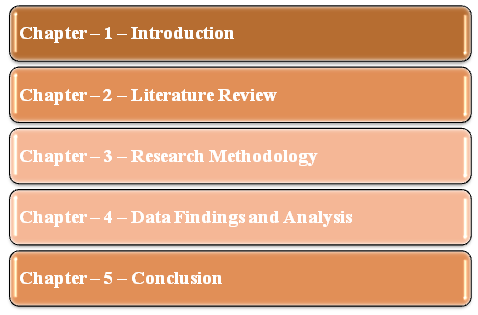
Figure.1: Structure of the Dissertation
(Source: Created by the learner)
1.7 Summary
This chapter has highlighted that there could be a link between the GSC on demand management and customer relationship management. Based on this fact, the research aims, objectives and research questions are developed. The chapter has also stated the reason for conducting the research.
Chapter – 2 – Literature Review
2.0 Introduction
A literature review can be considered as the comprehensive summary of various research papers on a particular topic for understanding the gaps that can be filled in future research. The present chapter reviews a range of peer-reviewed research articles based on the implementation of the GSCM approaches to control demand and supply and customer relationship management.
2.1 The concept and importance of GSC, demand and supply as well as customer relationship management
According to Geng, Mansouri & Aktas (2017), GSCM is the integration of environmental considerations within SCM. In this context, Jermsittiparsert, Namdej & Somjai, (2019) stated that GSCM is the approach to link the sustainable business practices for product designing, sourcing and selection of materials, manufacturing and delivering the products. It has been also emphasized that the management of the products after a useful life is also a part of GSCM. Hence, the GSC is not only influential to help organizations to abide by the governing legislation for environmental management but also to gain higher business outcomes through the reduction of the operational costs.
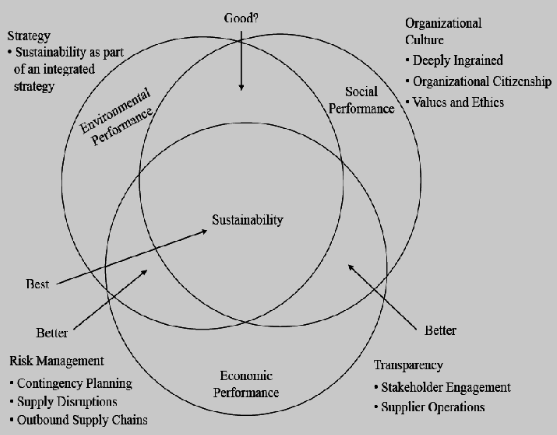
Figure.2: Concept of GSCM
(Source: Geng et al., 2017)
In the context of the SC, demand management (DM) has been defined as the discipline that evaluates the supply chain from the perspective of the customer and orients the various supply chain procedures for meeting the requirements of the customers. According to Cousins, Lawson, Petersen & Fugate (2019), demand management relates to various important business functions such as demand forecasting, supply planning, demand analysis and sales and operation planning. CRM has been explained as the approach to control the interaction of the organization with the existing and potential customers. CRM is important as it assists in building a strong relationship with the customers that result in greater customer loyalty and retention leading to business growth.
2.2 The moderating role of GSCM on the demand and supply of products and services
In recent research, Shafique, Asghar & Rahman, (2017) has described that GSCM practices play a moderating role in the demand and supply management and customer relationship management. The pressure that acts on the organizations originating from the end of the customers is considered as the demand. Being aware of the environmental hazards such as the increase of greenhouse gases, air pollution, and global warming that threaten individuals leads them to consider the environmental impacts of the materials they use. According to Rahmani and Yavari (2019), such references of the consumers regarding the products impact the business organizations, especially on their supply chains. The researcher has also mentioned that traditionally business organizations were judged by the consumers on the basis of the product quality, degree of fairness and the approach to solve the problems, however, in the recent era, the demand of the customers has shifted toward the practices of accounting the environmental ethics.
In the view of Chavez, Yu, Feng & Wiengarten (2016), the attention of the public on the overall condition of the natural environment has increased and for meeting this increased demand, the implementation of the sustainable SCM practices is indispensable. In this context, Sutduean, Joemsittiprasert & Jermsittiparsert, (2019) explained that the GSCM along with its approach to decrease the carbon footprint, promote the use of the reusable and recyclable material, and the adopt green technologies for the manufacturing and transport of the products along the supply chain is much effective to meet the increasing customer expectations leading to better management of the demand and supply.
2.3 The impact of effective demand and supply management on customer relationship management
As opined by Sehnem and Oliveira (2016), the GSCM includes different aspects that are the design of green supply chain, green operational management, green purchasing, green manufacturing, lean manufacturing, and green marketing. The implementation of these aspects of the GSC in an organization increases the efficiency of the organization to meet the demands of the customers. In this context, Aljawarneh and Al-Omari, (2018) have emphasized that increased efficiency of the demand and supply management regarding environmentally friendly products and business processes enables business organizations to gain increased customer loyalty.
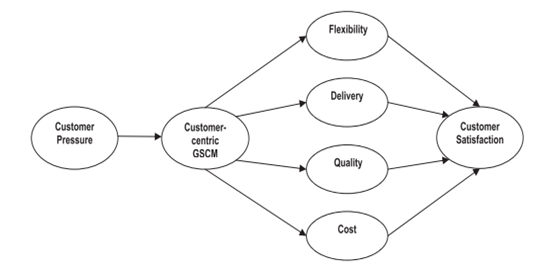
Figure.3: Impact of GSCM on customer satisfaction
(Source: Mahmood and Kess, 2016)
It has been identified that demand management is the process that is concentrated on predicting the demand of the customers and identifying the way in which synchronization of the demand is possible with the supply chain capabilities. Therefore, the data on CRM is highly influential for developing demand management strategies. On the other hand, Mahmood and Kess, (2016) have emphasized that demand management based on the GSC can increase the ability of the businesses to understand and address the characteristics and behaviour of the consumers and thereby leading to a better customer relationship management.
2.4 The ways in which organizations can enhance CRM by implementing green supply chain
In the view of Celikbilek and Süer (2020), the majority of the manufacturing organizations across the world are now adopting GSCM policies due to the increased demand from the end of the customers, competitors as well and the government. On the other hand, Sehnem and Oliveira, (2016) have emphasized more on increasing the pressure on the suppliers to adopt green principles. The author has further added to the statement that environmentally preferred purchasing of the raw materials can also help manufacturing organizations to better adapt the green supply chains. Green manufacturing is another approach through which businesses can implement green supply chains to improve demand management capability and enhance the level of customer relationship management. Organizations can approach green manufacturing by enhancing the efficiency of the production level, decreasing the costs for raw materials, improving the basic design, reducing the carbon footprint at the manufacturing unit and by increasing the expense of environment safety measures. According to Rahmani and Yavari (2019), the use of environmentally friendly raw materials and the eco-friendly packaging materials is another core concept of green manufacturing which can be facilitated for increasing the ability of the companies to control the demand and supply and enhance the customer relationship management.
2.5 Conceptual Framework
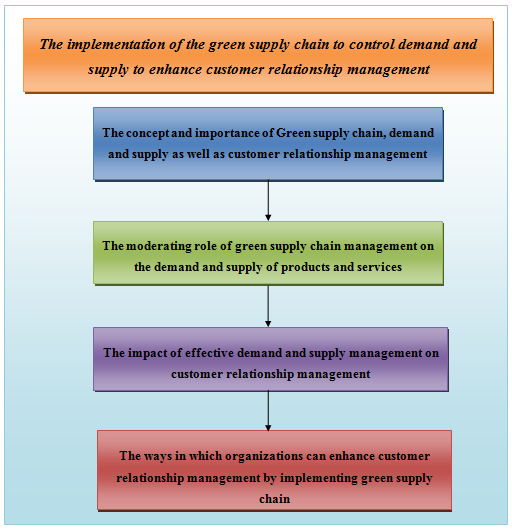
Figure.4: Conceptual Framework
(Source: Created by the learner)
2.6 Gap of Literature
The reviewed research articles include strong information regarding the concepts and importance of the three variables that are the green supply chain, demand and supply and the customer relationship management. However, the interrelationship between the three variables, especially the way in which green supply chains of organizations can control CRM through efficient demand management, is not approached in the previous research. Therefore, this lack of information creates a gap in the literature and provides the scope for further research in this area.
2.7 Summary
This chapter has explored the concept of the green supply chain, demand and supply management and CRM and the interrelationships between these three variables from the existing research papers. A conceptual map has been developed and the literature gap has been identified based on which the present research has proceeded.
Chapter – 3 – Research Methodology
3.0 Introduction
As opined by Rasheed (2017), research methodology defines an empirical framework that enables the identification of diverse methods of collecting sensitive and relevant information about the study. With the help of different methods of research methodology interrelationship between different variables involved in the study has been discussed. The main purpose of this research methodology is to identify the significant impact of integrating the GSC for controlling the demand and supply of the market while enhancing customers and corporate relationships.
3.1 Research Onion
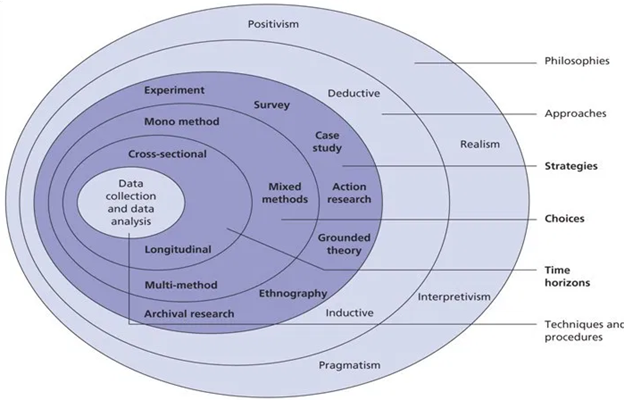
Figure.5: Research Onion
(Source: Saunders, Lewis & Thornhill, 2009)
3.2 Research Philosophy
Research philosophy is used to identify and understand the sources and nature of the study while developing knowledge. As observed by Fusaro et al., (2017), research philosophy is categorized into positivism, interpretivism, realism as well as pragmatism. After analyzing the requirement and significance of the study, interpretivism philosophy is identified as the most suitable method for doing research. Interpretivism is commonly performed when a secondary method of collecting data is used. This method is based on the naturalistic approaches; hence it would be easy to adapt necessary changes during the time of conducting research in a flexible manner. Hence, with the help of this philosophical approach, the study on the GSCfor maintaining a strong relationship between corporate units and customers can be studied in depth.
3.3 Research Approach
The research approach is divided into three broad categories: deductive, inductive as well as an abductive research approach. To gain relevant findings on the study, inductive research approaches are considered as the best suitable method. The biggest advantages of collaborating inductive approach are that while conducting the research, the researcher would be able to work with diverse probabilities (Iordache-Platis and Papuc 2019). The secondary reason is, the inductive approach begins with specific observation.
3.4 Research Design
Research design facilitates smooth sailing of diverse research operations yielding efficient and more relevant information along with minimal expenditures, time as well as money (Abdulkadiro?lu, Angrist, Narita & Pathak, 2017). Research design is divided into two categories, exploratory and explanatory. However, analysing elements associated in the study, the explanatory research design is performed to evaluate necessary findings for the study. Explanatory research design allows the researcher to understand the relationship between different variables associated with GSCM. Besides, this enables access to a vast range of available information.
3.5 Data Collection and analysis
Data collection methods enable us to analyse crucial information and store it for conducting research (Mohr, Riper & Schueller, 2018). Primary method and secondary are identified as the main methods of collecting data. However, to raise the credibility of the study, secondary methods of collecting data have been performed in which thematic analysis would be conducted. Secondary methods are suitable when the available resources are limited during the time of conducting research.
3.6 Population and Sampling
There are two sampling techniques commonly integrated for conducting research that involve probability sampling techniques and non-probability sampling techniques (Tuffour 2017). Non-random sampling technique is prefered for this study as secondary and thematic analysis has been considered. This approach of sampling techniques is identified as time and cost-effective during the time of conducting research. Research population defines a number of sampling or population are involved in conducting the research. 3 themes are developed with 3 core peer-reviewed journal articles and 12 supportive peer-reviewed journal articles. As opined by Abdulkadiro?lu, Angrist, Narita & Pathak, (2017), integrating thematic analysis provides a large range of flexibility.
3.7 Ethical Considerations
As per the secondary methods of collecting data necessary ethical considerations like Citation, referencing, intellectual property rights, appropriate analysis of secondary data has been maintained (Kennedy 2017). To maintain the credibility and reliability of the study credit has been given to all the respective authors, assistance from whose research has been considered.
3.8 Summary
It can be evaluated that for sustaining relevant findings on the topic of the GSCfor controlling supply and demand while maintaining an effective relationship with the customers, secondary along with thematic analysis is found best suitable. As the available resources in aspect to time and finance is limited for which secondary method and thematic analysis are preferred. Hence, from the above discussion it is evaluated that with effective integration of research approach, design and philosophy, relevant information can be sustained while accessing relevant sources.
Chapter – 4 – Data Findings and Analysis
4.0 Introduction
Data from secondary sources like peer-reviewed journal articles are collected. Based on the collected data, three themes have been prepared that are analysed in this chapter with the thematic analysis techniques.
4.1 Theme 1: Trends in GSCM and its role in managing demand and supply in organizations
GSCM is an emerging trend in businesses all over the world. However, research on the key trends of GSCM has identified several aspects that are currently being followed by organisations to improve demand and supply management. In recent research, Zhu, Feng & Choi. (2017) has explained that the majority of the businesses are depending on demand planning at the end of the cycle. It has been also emphasized by the researchers that companies are adopting more of a demand-driven focus to influence and manage demand in a more efficient way with the GSCM. The researcher has further explained that it is important for the organisation to rationalize what their organisation is best at manufacturing, developing, selling, and delivering for adopting a demand-driven model. The demand-driven approach of the GSC helps an organisation in the development of a more consumer focus mindset without losing focus on operational efficiency. GSCM which is universally recognised as the achievement of long-term sustainability in the context of enhanced ecological, climate, and environmental complexity. The trend of GSCM has proceeded through waste management, supply chain partnering, and closed-loop supply chain management.
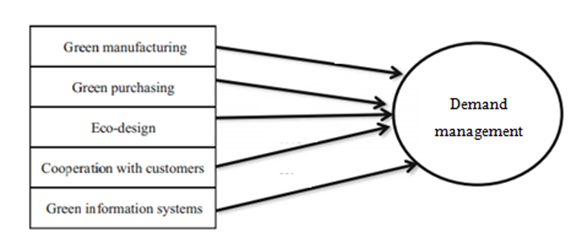
Figure.6: Impact of GSCon Demand management
(Source: Roehrich, Hoejmose & Overland, 2017)
Cooperation with green raw material suppliers is another emerging trend in manufacturing businesses. In this context, the research conducted by Alananzeh, Algiatheen, Ryati, Albayyari & Tarhini (2017), demonstrates that green raw material suppliers can perform as key partners for the businesses in order to reinforce green resources and green activities. However, in this context, Roehrich, Hoejmose & Overland, (2017) has explained that partnering with green raw material suppliers can require critical policy instruments that can be adopted in order to address the proposed innovative green business model. GSCM policies are currently assisting businesses to enhance their purchase of raw materials and manufacturing operation systems. The trains of GSCM include various practices such as green manufacturing, green purchasing, green management, green marketing and reverse logistics. Bag, Anand & Pandey (2017) stated that increased demand management for business organisations can be improved by the implementation of green practices in the supply chain. Therefore, implementation of the GSCis likely to play a vital role bought at the organisation level as well as the environmental level.
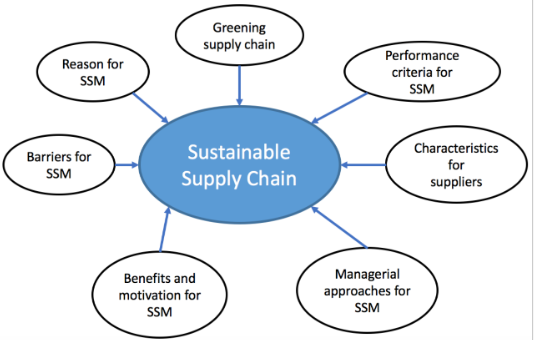
Figure.7: Various aspects to sustainable supply chain
(Source: Bag et al., 2017)
As the demand of the customers regarding the environmentally friendly products processes packaging materials and delivery options is racing organisations implementing sustainable supply chain management practices can be effective in supply products that are manufactured with environment-friendly raw materials and packaged with sustainable, reusable and recyclable materials (Green, Inman, Sower & Zelbst, 2019). In order to support the trend of sustainable manufacturing, packaging, and delivery of the products to the customers, organisations are selecting suppliers not only based on their economic and technical criteria but also on the basis of their respect for the environmental and social standards. A growing number of organizations are focusing on avoiding child labour, forced labour and increasing the transparency through the enhancement of communication levels with the key stakeholders. Such practices of communication not only allow the businesses to make the supply chain more sustainable but also to gain information relating to the demand for sustainable products and services.
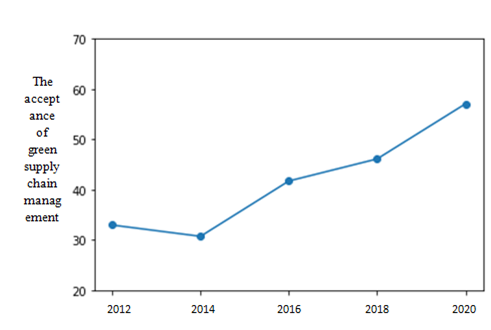
Figure.8: The trend of adopting GSCM across the UK based organizations
(Source: Green et al., 2019)
4.2 Theme 2: Implementation of GSCM to moderate CRM mediated by demand management
GSCM has been widely applied by business organizations as the majority of the research in this context has shown that it can bring greater ability to manage demand and customer relationship management. Geng, Mansouri, Aktas & Yen, (2017) stated that customers put pressure on the organizations for the reduction of the negative or harmful impact of their activities. Therefore it signifies that the adoption of GSCpractices plays a positive role in responding to the increased pressure from the consumers. Undeniably, GSCimplementation leads to strong CRM through the better management of the demand and supplies. A research conducted by Sharma, Chandna & Bhardwaj (2017), demonstrated that GSCM can reduce the production of waste material which is highly preferred by the customers. Therefore, the presence of GSCM enables an organization to effectively meet the consumer demands regarding environmental management through the supply of environment-friendly products, development of green manufacturing processes and implementation of green marketing processes.
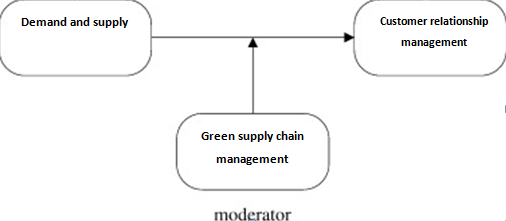
Figure.9: Moderator role of GSCM
(Source: Sharma et al., 2017)
According to Colicchia, Creazza & Dallari, (2017), a moderating role can be defined as the positive relationship between a dependent variable and another independent variable can be standing with the presence of a moderator. In recent research Suryanto, Haseeb & Hartani (2018), has identified that GSCM can perform as a moderator within the relationship between demand management and customer relationship management. The researchers have further explained that demand and supply management as an independent variable while CRM has been described as the dependent variable. Organisations implementing GSCM related practices can respond to the formal control from the end the customer regarding the preference of sustainable product, packaging delivery option and loyalty from the end of the customer. The CRM of the organizations is strengthened by the approach of the green supply chain. As the GSCM is designed to meet the demands of the customers such as the timely delivery of the products, sustainable and ethical sourcing of the raw materials, and utilization of the electric vehicles in the transport of the goods and products, the management of the supply is also done effectively based on the demands. Apart from that with the implementation of sustainable practices in the supply chain, organizations are more likely to increase the transparency of the organizations regarding the sourcing, manufacturing and other business processes. Therefore, communication regarding business elements is also achieved in the easiest ways.
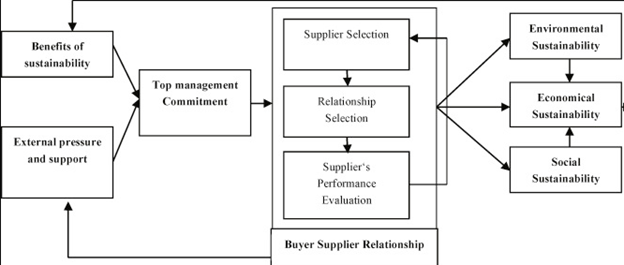
Figure.9: The functioning of GSCM
(Source: Suryanto et al., 2018)
According to Irani, Kamal, Sharif & Love (2017), the cooperation with the customers is helpful for the organizations as it can improve the performance of the organizations especially the economic performance. The researcher has further explained that in GSCM, wherein the demand of the customers toward increased environmental management is implemented in the supply chain, organizations are driven to build relationships with ethical and sustainable suppliers. Such business relationships are more likely to increase the commitment and trust in the customer-supplier relationships with the improvement of the cooperation and the loyalty and therefore are valuable for the organizations in order to enhance the organizational performance.
4.3 Theme 3: Recommendations regarding the implementation of GSCM for enhanced customer relationship management
GSCM is highly questioned in the context of business regarding its effectiveness in creating economic value. As stated by Laari, Töyli & Ojala (2017), a number of organizations still believe that sustainable supply chain management does not create any economic value. Other major obstacles in the path of the implementation of the GSCcan be categorized into internal and external obstacles. The internal obstacles to GSCresult from the lack of reliable technological tools for evaluating the social and environmental performance and the lack of measurement indicators in relation to economic performance. On the other hand, the external obstacles stem from a consumer who is not much conscious about the environmental aspects and the regulations that are not much rigorous regarding the social and environmental objectives. Hence, it can be explained that for effective implementation of GSCM for enhancing CRM via controlling the demand and supply, the mitigation of the impact of the obstacles is necessary.
In the opinion of Dubey, Gunasekaran & Papadopoulos (2017), Business organizations can promote an organizational culture for supporting the social and environmental approach in supply chain management. In consecutive research, Green, Inman, Sower & Zelbst, (2019) has explained that the success of the sustainable organizational culture-based approach is highly conditioned by the mobilization of technological, material and financial resources. The researcher has further added to the statement that investment in the department of research and development is highly required along with the recruitment of highly skilled employees for generating innovative sustainable ideas along the logistics chain. As stated by Rezaee, Dehghanian, Fahimnia & Beamon (2017), for the mitigation of the barriers arising from the end of the employees in adopting the green supply chain, an organization can take the approach of decisive commitment from management so that a communication policy can be promoted and permanent exchanges in the environmental and ethical values can be raised. It has been also emphasized that such an approach is able to raise the awareness levels of the staff regarding the adoption of the GSCM.
In the view of Carvalho, Govindan, Azevedo & Cruz-Machado (2017), successful implementation of the green supply chains depends highly on the recognition of relevant organizational goals and long term planning to achieve the recognized goals. However, it has also been indicted by the researcher that the most suitable strategy to implement a GSCrelies on government policies, regulations and awareness levels of the customers. Therefore the subsidiaries and policies that are friendly to the environment are critical in the process of implementing GSCM in different industries. In the opinion of Rezaee et al. (2017), allowing trained professionals who have appropriate knowledge in GSCM is a critical approach for the achievement of desired results as well as the mitigation of the identified obstacles in the path of implementing green supply chains. In addition to it, the author has further provided importance on increasing the awareness levels of the suppliers, professionals as well as the end-users of the product regarding the GSCM. It has been emphasized that enhancement of the avengers level can add in the successful implementation of GSCM in organisations leading to increase in fact on the demand and supply management as well as the customer relationship management.
4.4 Summary
This chapter included the collected secondary data from the peer-reviewed journal articles on the three variables and their interrelationships and their thematic analysis. The findings indicate that GSC implementation plays an active moderator role on the demand management and customer relationship management.
Chapter – 5 – Conclusion
5.0 Conclusion
The aim of this present research was to investigate the moderating role of implementing GSCM to control demand and supply to enhance customer relationship management. In order to reach the aim, the researcher has completed the literature review and applied a secondary research method to collect data regarding the research questions. The findings of the research depict that GSCM is an emerging concept in business in order to meet the demands of the customers regarding environmental concerns. Demand management has been identified to be focused on the prediction of the consumer demands and recognition of the approaches to synchronize the demand along with the capabilities of the supply chain. Another variable of the research is the CRM which has been identified to be positively impacted by demand and supply management under the influence of GSCM.
The outcome of this research predicts the GSC practices to be a strong moderator within the relationship between demand and supply management and customer relationship management. It means that under the presence of sustainable practices in supply chain organizations are more likely to forecast the demands of the customers and promote the supply of the products and thereby can achieve the CRM goals in an effective way. The research has also identified a number of obstacles such as the internal and external obstacles that prevent the implementation of GSCpractices for better demand management and customer relationship management. It has been identified that the implementation of the GSCcan be promoted with the application of GSCM policies. Apart from that, the development of relationships with ethical and sustainable suppliers can also enhance the ability of the organizations to meet the demands of the customers and gain greater CRM abilities.
5.1 Linking with the Objectives
Objective 1:
The first objective of the study is discussed in the 2.1 section along with the 2.2 section of literature reviews.
Objective 2:
The second objective of the study is explained in the 2.3 section of the literature review. Theme 1 under thematic analysis also discusses factors associated with objective 2.
Objective 3:
The third objective of the study was discussed in the 2.4 section of the literature review. Besides, a major point of this objective has been discussed in theme 2 as well as theme 3 under thematic analysis.
5.2 Recommendations
The topic GSC is a broader term for contemporary business associated with maintaining its relationship with potential customers as well as to render sustainability development for a competitive edge. It has been evaluated that corporate associates are encountering diverse hurdles like lack of skills in recognizing advanced technologies in implementing GSCM. However, it can be recommended that corporate associates can explore core capabilities of different information technology tools like Artificial intelligence (AI) and cloud computing (Tramarico, Salomon & Marins, 2017). Hence, for the future perspective, the term of GSCand its significance can be discussed in a wider manner.
5.3 Limitations of the Study
For conducting the research on the topic of GSCM, only secondary methods of collecting data have been used. It has been evaluated that the available resources in aspects to money and time was limited, due to which the primary method of collecting data was avoided. Besides, the concept of the GSC is vast and in the study, its significance has been limited to only rendering strong customers connections.
5.4 Future Scope of the Study
In the future, research can be conducted to recognize the impact of the GSC, DM and CRM on organizational performance. In the future, the researcher may choose a particular industry, for instance, the manufacturing industry to conduct the research with a primary quantitative and qualitative data collection method.
References
Abdulkadiro?lu, A., Angrist, J. D., Narita, Y., & Pathak, P. A. (2017). Research design meets market design: Using centralized assignment for impact evaluation. Econometrica, 85(5), 1373-1432.
Alananzeh, O., Algiatheen, N., Ryati, R., Albayyari, R., & Tarhini, A. (2017). The impact of employee’s perception of implementing GSCM on hotel’s economic and operational performance. Journal of Hospitality and Tourism Technology.
Aljawarneh, N., & Al-Omari, Z. (2018). The role of enterprise resource planning systems ERP in improving CRM CRM : An empirical study of safeway company of Jordan. International Journal of Business and Management, 13(8), 86-100.
Bag, S., Anand, N., & Pandey, K. K. (2017). GSCM model for sustainable manufacturing practices. In GSCM for sustainable business practice (pp. 153-189). IGI Global.
Carvalho, H., Govindan, K., Azevedo, S. G., & Cruz-Machado, V. (2017). Modelling green and lean supply chains: An eco-efficiency perspective. CRM assignment Resources, Conservation and Recycling, 120, 75-87.
Celikbilek, C., & Süer, G. A. (2020). Supply Chain Design Approaches for Dual Demand Management Strategies. In Supply Chain and Logistics Management: Concepts, Methodologies, Tools, and Applications (pp. 491-526). IGI Global.
Chavez, R., Yu, W., Feng, M., & Wiengarten, F. (2016). The effect of customer?centric GSCM on operational performance and customer satisfaction. Business Strategy and the Environment, 25(3), 205-220.
Chelly, A., Hadj-Alouane, A., Noiura, I., & Frein, Y. (2017, October). A stochastic model for analyzing the combined effect of demand uncertainty and carbon tax within the context of GSCDesign. In 7th International Conference on Industrial Engineering and Systems Management (IESM).
Choi, S. B., Min, H., Joo, H. Y., & Choi, H. B. (2017). Assessing the impact of GSCpractices on firm performance in the Korean manufacturing industry. International Journal of Logistics Research and Applications, 20(2), 129-145.
Colicchia, C., Creazza, A., & Dallari, F. (2017). Lean and GSCM through intermodal transport: insights from the fast moving consumer goods industry. Production Planning & Control, 28(4), 321-334.
Cousins, P. D., Lawson, B., Petersen, K. J., & Fugate, B. (2019). Investigating GSCM practices and performance. International Journal of Operations & Production Management.
Dougherty, M. R., Slevc, L. R., & Grand, J. A. (2019). Making research evaluation more transparent: Aligning research philosophy, institutional values, and reporting. Perspectives on Psychological Science, 14(3), 361-375.
Dubey, R., Gunasekaran, A., & Papadopoulos, T. (2017). GSCM: theoretical framework and further research directions. Benchmarking: An International Journal.
Fusaro, R., Viola, N., Ferretto, D., Cresto Aleina, S., Fioriti, M., & Boggero, L. (2017). Methodology for the Safety and Reliability assessment of hypersonic transportation systems in conceptual design activities. In 21st AIAA International Space Planes and Hypersonics Technologies Conference (p. 2406).
Geng, R., Mansouri, S. A., & Aktas, E. (2017). The relationship between GSCM and performance: A meta-analysis of empirical evidences in Asian emerging economies. International Journal of Production Economics, 183, 245-258.
Geng, R., Mansouri, S. A., Aktas, E., & Yen, D. A. (2017). The role of Guanxi in GSCM in Asia's emerging economies: A conceptual framework. Industrial Marketing Management, 63, 1-17.
Green, K. W., Inman, R. A., Sower, V. E., & Zelbst, P. J. (2019). Comprehensive supply chain management model. Supply Chain Management: An International Journal.
Green, K. W., Inman, R. A., Sower, V. E., & Zelbst, P. J. (2019). Impact of JIT, TQM and GSCpractices on environmental sustainability. Journal of Manufacturing Technology Management.
Iordache-Platis, M., & Papuc, R. M. (2019, November). Comparative Study of Academic Leadership Solutions for Civic Engagement: Role of Research Strategy and Academic Rankings. In European Conference on Management, Leadership & Governance (pp. 252-261). Academic Conferences International Limited.
Irani, Z., Kamal, M. M., Sharif, A., & Love, P. E. (2017). Enabling sustainable energy futures: factors influencing GSCcollaboration. Production Planning & Control, 28(6-8), 684-705.
Jermsittiparsert, K., Namdej, P., & Somjai, S. (2019). GSCPractices and Sustainable Performance: Moderating Role of Total Quality Management Practices in Electronic Industry of Thailand. International Journal of Supply Chain Management, 8(3), 33-46.
Kennedy, A. M. (2017). Macro-social marketing research: philosophy, methodology and methods. Journal of Macromarketing, 37(4), 347-355.
Khan, S. A. R., Zhang, Y., Anees, M., Golpîra, H., Lahmar, A., & Qianli, D. (2018). GSCM, economic growth and environment: A GMM based evidence. Journal of Cleaner Production, 185, 588-599.
Laari, S., Töyli, J., & Ojala, L. (2017). Supply chain perspective on competitive strategies and GSCM strategies. Journal of Cleaner Production, 141, 1303-1315.
Mahmood, S., & Kess, P. (2016). An overview of demand management through demand supply chain in fashion industry. International Journal of Management Science and Business Administration, 2(12), 7-19.
Mohr, D. C., Riper, H., & Schueller, S. M. (2018). A solution-focused research approach to achieve an implementable revolution in digital mental health. JAMA psychiatry, 75(2), 113-114.
Rahmani, K., & Yavari, M. (2019). Pricing policies for a dual-channel GSCunder demand disruptions. Computers & Industrial Engineering, 127, 493-510.
Rasheed, A. K. (2017). A study on marketing strategies of home appliance companies. ZENITH International Journal of Business Economics & Management Research, 7(2), 18-25.
Rezaee, A., Dehghanian, F., Fahimnia, B., & Beamon, B. (2017). GSCnetwork design with stochastic demand and carbon price. Annals of Operations Research, 250(2), 463-485.
Roehrich, J. K., Hoejmose, S. U., & Overland, V. (2017). Driving GSCM performance through supplier selection and value internalisation. International Journal of Operations & Production Management.
Saunders, M., Lewis, P. and Thornhill, A., 2009. Research onion. Research methods for business students, pp.136-162.
Sehnem, S., & Oliveira, G. P. D. (2016). GSCM: an analysis of the supplier-agro industry relationship of a Southern Brazilian company. BBR. Brazilian Business Review, 13(6), 158-190.
Shafique, M., Asghar, M., & Rahman, H. (2017). The impact of GSCM practices on performance: Moderating role of institutional pressure with mediating effect of green innovation. Business, Management and Education, 15(1), 91-108.
Sharma, V. K., Chandna, P., & Bhardwaj, A. (2017). GSCM related performance indicators in agro industry: A review. Journal of Cleaner Production, 141, 1194-1208.
Shibin, K. T., Gunasekaran, A., Papadopoulos, T., Dubey, R., Singh, M., & Wamba, S. F. (2016). Enablers and barriers of flexible GSCM: A total interpretive structural modeling approach. Global Journal of Flexible Systems Management, 17(2), 171-188.
Suryanto, T., Haseeb, M., & Hartani, N. H. (2018). The correlates of developing GSCM practices: Firms level analysis in Malaysia. International Journal of Supply Chain Management, 7(5), 316.
Sutduean, J., Joemsittiprasert, W., & Jermsittiparsert, K. (2019). Supply Chain Management and Organizational Performance: Exploring Green Marketing as Mediator. International Journal of Innovation, Creativity and Change, 5(2), 266-283.
Tramarico, C. L., Salomon, V. A. P., & Marins, F. A. S. (2017). Multi-criteria assessment of the benefits of a supply chain management training considering green issues. Journal of Cleaner Production, 142, 249-256.
Tuffour, I. (2017). A critical overview of interpretative phenomenological analysis: a contemporary qualitative research approach. Journal of Healthcare Communications, 2(4), 52.
Zhu, Q., Feng, Y., & Choi, S. B. (2017). The role of customer relational governance in environmental and economic performance improvement through GSCM. Journal of Cleaner Production, 155, 46-53.












